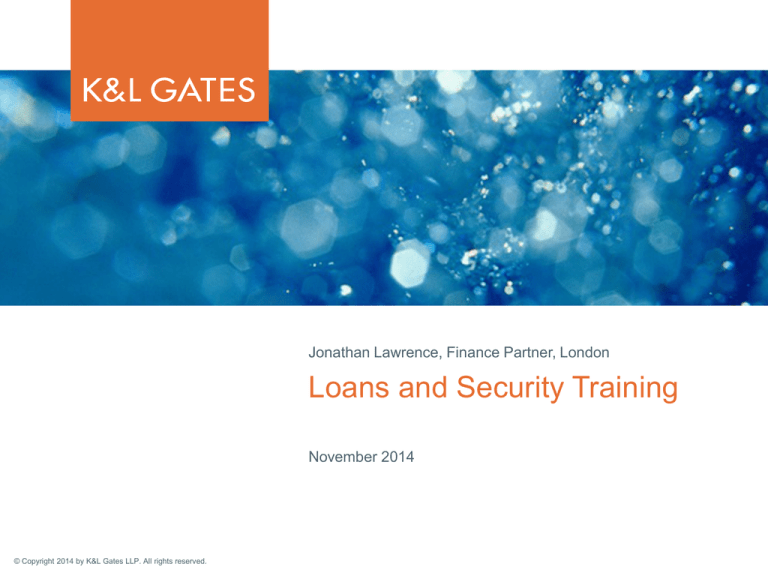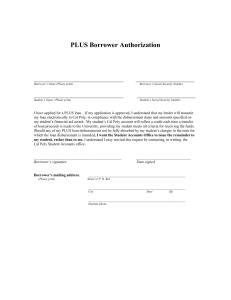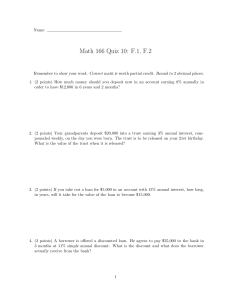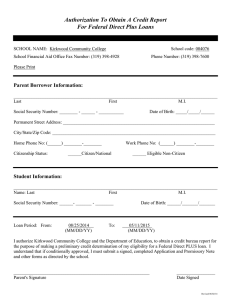
Jonathan Lawrence, Finance Partner, London
Loans and Security Training
November 2014
© Copyright 2014 by K&L Gates LLP. All rights reserved.
LOANS AND SECURITY TRAINING
A. Entering into a loan facility
B. Managing an ongoing facility
C. Managing defaults
klgates.com
2
A. ENTERING INTO A LOAN FACILITY
1. Overview of a loan agreement
a) Parties- lender and other finance parties,
borrower(s), occasionally third party guarantor(s)
b) Obligations of parties - Borrower must repay money
in full with pre-arranged interest, and comply with all
terms of agreement. Lender must allow borrower to
borrow money based on agreement, and comply
with all terms.
klgates.com
3
A. ENTERING INTO A LOAN FACILITY (cont’d)
c) Term sheets - created once lender has investigated
the borrower, highlights key terms of agreement.
Mostly non-binding but should contain a binding
confidentiality clause and lender may insist that
borrower pays lender’s expenses even if facility
agreement is not signed
d) Purpose of the facility - describes type and amount
of loan, allows lender to specify how loan facility is to
be used in order to limit chances of loan not being
repaid
klgates.com
4
A. ENTERING INTO A LOAN FACILITY (cont’d)
2. Types of facilities
a) Overdrafts - provide cash in a readily accessible
form to meet any temporary shortfalls in working
capital. Simple and quick to arrange, and
uncommitted so no commitment fees and few legal
fees. On-demand nature means high interest rates
and bank charges, so not suitable for long term
payments or large investments.
klgates.com
5
A. ENTERING INTO A LOAN FACILITY (cont’d)
2. Types of facilities
b) Term Loans - lender commits to lending money to
borrower for a specific amount of time, usually
between one and five years. Allows certainty of
repayment time and interest rate lower than an
overdraft. Often borrower must take specified loan
amount all at once. Cannot be re-borrowed once it is
repaid, and limited in term.
klgates.com
6
A. ENTERING INTO A LOAN FACILITY (cont’d)
2. Types of facilities
c) Revolving Credit Facilities - lender agrees to lend
a specific amount of money, over a specific amount
of time, but borrower can draw out and re-pay
money as and when it chooses throughout the term
of the loan. Committed loan with maximum flexibility.
Bank, however, may impose a repayment schedule,
may create upper and lower limits on what can be
drawn at any one time, and there are usually high
commitment fees.
klgates.com
7
A. ENTERING INTO A LOAN FACILITY (cont’d)
2. Types of facilities
d) Syndicated loans - A loan or other credit facility provided
by more than one lender to a borrower (or associated
borrowers) under the terms and conditions of one facility
agreement. A lender may transfer, usually by novation, all
or part of its commitment under the syndicated facility to
another lender or lenders - reduces original lender’s
exposure and reward. Together the group of lenders are
known as the syndicate.
klgates.com
8
A. ENTERING INTO A LOAN FACILITY (cont’d)
3. Introduction of example documents and
scenarios
a) Syndicated real estate term loan agreement
b) Short form intercompany loan agreement
c) Debenture
klgates.com
9
A. ENTERING INTO A LOAN FACILITY (cont’d)
4. Types of security:
a) Charge - Security over an asset which gives the
lender the right to have the particular asset and its
proceeds of sale appropriated to the discharge of
the debt in question. A charge does not transfer
ownership; it is an encumbrance on the asset.
b) Mortgage - The transfer of the ownership of an asset
by way of security for particular obligations on the
express or implied condition that it will be retransferred on the discharge of the secured
obligations.
klgates.com
10
A. ENTERING INTO A LOAN FACILITY (cont’d)
4. Types of security:
c) Pledge - lender takes and retains an asset, but borrower
retains legal title and ownership of asset. If borrower
defaults on repayment, lender gains a legal propriety
interest in asset, and becomes legal owner if borrower
becomes insolvent. Tangible assets and documents of
title to goods can be pledged, but not intangible assets
or future assets. Asset must be delivered, physical
delivery of asset or delivery of deed etc.
d) Lien - A right which entitles a party to hold on to assets
in his possession pending payment of a debt owed.
klgates.com
11
A. ENTERING INTO A LOAN FACILITY (cont’d)
5. Practical Issues/Commercial considerations
a) Requirement of loan facilities
b) Facts of consideration before entering into loan
facility
c) Solvency rules in different jurisdictions
d) Expectations of repayment
e) Consideration to type of facility: in accordance with
business model? Cash flow secured?
klgates.com
12
A. ENTERING INTO A LOAN FACILITY (cont’d)
6. Lender’s Principal Concerns
a) Will it ever recover the capital sum advanced?
b) In the interim, will it receive interest payments
promptly?
c) Who is the borrower and its sponsor?
d) Reputational risk?
klgates.com
13
A. ENTERING INTO A LOAN FACILITY (cont’d)
7. Borrower’s Principal Concerns - Objective to:
a) Keep expenses to a minimum, particularly
obligations to reimburse the lender for its expenses
and additional charges that may be difficult to
quantify.
b) Ensure that the lender’s attempts to monitor the
borrower's activities (for example, in the covenants
and events of default) do not interfere with the
borrower's ability to run its business.
klgates.com
14
A. ENTERING INTO A LOAN FACILITY (cont’d)
7. Borrower’s Principal Concerns- Objective to:
c) Temper its obligations in the agreement with
reasonableness and materiality thresholds. These
mechanisms add an element of uncertainty for the
lender, something which is unpopular if and when
determining whether an event of default has
occurred or a covenant has been breached.
d) Ensure certainty by including objective rather than
subjective tests if terms are conditional on a third
party's opinion.
klgates.com
15
A. ENTERING INTO A LOAN FACILITY (cont’d)
7. Borrower’s Principal Concerns- Objective to:
e) Increase flexibility with grace periods and mitigation
clauses before events of default are triggered.
f) In the case of a syndicated loan, allow amendments
to the loan documents with the consent of a certain
majority of the lenders, thereby facilitating waivers
and preventing a single lender from having a power
of veto.
klgates.com
16
A. ENTERING INTO A LOAN FACILITY (cont’d)
8. Interest & Costs
a) Margin, LIBOR- rate of interest a lender will offer to
lend to other lenders- will change for each
successive interest period under a loan
b) Rates available for each type of facilityThe interest rate on each Loan for each Interest Period is the
percentage rate per annum, determined by the Lender to be the
total of:
the Margin;
LIBOR; and
the Mandatory Costs (if any).
klgates.com
17
A. ENTERING INTO A LOAN FACILITY (cont’d)
8. Interest & Costs
c) Rates for renewal of facility
d) Default interest - The rate of default interest payable
in loans is usually 1% or 2% above the rate payable
in the ordinary course of the agreement where all
the sums are paid on time.
klgates.com
18
A. ENTERING INTO A LOAN FACILITY (cont’d)
9. Covenants
a) Financial Covenants and Ratios - lender will prepare
financial projections of how loan is to be repaid.
Financial covenants are a series of tests to assess if
the performance of the borrower is living up to those
projections.
b) Non-Financial Covenants
The ranking of the borrower's obligations under the facility
agreement (so as to preserve the status of the lender in
relation to other creditors of the borrower)
klgates.com
19
A. ENTERING INTO A LOAN FACILITY (cont’d)
9. Covenants
Restrictions on acquisitions, investments and capital
expenditure, sometimes restrictions on dividends paid by the
borrower (but not normally where the borrower is a listed
company).
Restrictions on incurring contingent liabilities (for example,
guaranteeing the indebtedness of a third party).
Control of change in the nature of its business.
Restrictions on further borrowing.
klgates.com
20
A. ENTERING INTO A LOAN FACILITY (cont’d)
9. Covenants
c) Negative Covenants, Negative Pledge- borrower
agrees not to create (or allow) any other security
without the lender’s consent
d) Information Covenants Diary Reminders - cover
the accounting information that needs to be supplied
on a regular basis from borrower to lender.
klgates.com
21
A. ENTERING INTO A LOAN FACILITY (cont’d)
10)Representations & Warranties
a) Repetition of Representations & Warranties - lender
seeks to minimise risks by producing list of
representations it wants borrower to make regularly.
Borrower can then consider list, and decide if
possible. An attempt to ascertain position of the
borrower.
klgates.com
22
A. ENTERING INTO A LOAN FACILITY (cont’d)
11) Security & Guarantees
a) Guarantee - promise to ensure that a third party
fulfils its obligations and/or a promise to fulfil those
obligations if that third party fails to do so. It is a
contractual agreement that creates a secondary
obligation to support a primary obligation of one
party to another. Either Personal Guarantee or
Corporate Guarantee.
klgates.com
23
A. ENTERING INTO A LOAN FACILITY (cont’d)
11) Security & Guarantees
b) Indemnity - promise to be responsible for another's
loss. Unlike a guarantee, it is a primary obligation
given by the indemnifier to the person to be
indemnified. It is independent to, and not contingent
on, the obligations of the borrower. This means that,
if the underlying transaction is set aside for any
reason, the indemnity will remain valid.
klgates.com
24
A. ENTERING INTO A LOAN FACILITY (cont’d)
11) Security & Guarantees
c) Letter of Comfort - written assurance often provided
by a parent company in respect of its subsidiary's
financial obligations to a lender. It is usually used
where the parent company is unable or unwilling to
give a guarantee but wishes to give some comfort to
the lender in respect of the subsidiary's ability to
perform its obligations. It is not usually intended to
be legally binding but it may give rise to a legally
binding obligation depending on the wording.
klgates.com
25
A. ENTERING INTO A LOAN FACILITY (cont’d)
12.Overview of Events of Defaults, Cross defaults,
MAC/MAE clauses
Non-payment
Non-compliance
Misrepresentation
Financial condition
Cessation of business
klgates.com
26
A. ENTERING INTO A LOAN FACILITY (cont’d)
13.Cross-defaults
A clause which operates by automatically defaulting a
party under Agreement A where borrower has
defaulted under Agreement B. A cross-default
provision effectively gives the non-defaulting party
under Agreement A the benefit of the default
provisions in Agreement B. Cross-default provisions
therefore have a domino effect.
klgates.com
27
A. ENTERING INTO A LOAN FACILITY (cont’d)
14.MAC / MAE Clauses
Clauses which highlight an event or circumstance
which could have a material adverse change or
material adverse effect. Not commonly used to default
the borrower.
klgates.com
28
B. MANAGING THE ONGOING FACILITY
1. Information CovenantsProvide for the basis on which the accounts are to be
prepared following generally accepted accounting
principles applied on a consistent basis from year to
year and will specify the frequency of the delivery of
information. This will certainly include the audited
annual accounts and probably unaudited semi-annual
accounts if they are published and, in some cases, the
lender may attempt to obtain more frequent
management accounts.
klgates.com
29
B. MANAGING THE ONGOING FACILITY
(cont’d)
2. Accounting InformationLender may request annual financial statements and
proforma balance sheets in order to check up on
borrower’s financial situation.
klgates.com
30
B. MANAGING THE ONGOING FACILITY
(cont’d)
3. Notification
4. Certification and Ratio Calculations
5. Other information
klgates.com
31
C. MANAGING DEFAULTS
1. Events of Default
a) Non-payment - borrower fails to pay any money
when due, unless non-payment caused by
administrative error/ technical problem/ disruption
events and payment is made within three days
b) Non-compliance - borrower fails to comply with any
provision of the Finance Documents and such
default is not remedied within 14 days of either the
lender notifying the borrower of the default and
asking for a remedy, or the borrower becoming
aware of the default
klgates.com
32
C. MANAGING DEFAULTS (cont’d)
1. Events of Default
c) Misrepresentation - any representation, warranty or
statement made that proves to be untrue, incorrect
d) Financial condition - any requirement of financial
condition is not satisfied
e) Cessation of business - borrower suspends or
threatens to suspend continuation of business
klgates.com
33
C. MANAGING DEFAULTS (cont’d)
2. Cross defaults
a) Any Borrowed Money is not paid when due or within
any originally applicable grace period.
b) Any Borrowed Money becomes due, or capable or
being declared due and payable, prior to its stated
maturity by reason of an event of default (howsoever
described).
klgates.com
34
C. MANAGING DEFAULTS (cont’d)
2. Cross defaults
c) Any commitment for any Borrowed Money is
cancelled or suspended by a creditor of the
Borrower by reason of an event of default
(howsoever described).
d) Any creditor of the Borrower becomes entitled to
declare any Borrowed Money due and payable prior
to its stated maturity by reason of an event of default
(howsoever described).
klgates.com
35
C. MANAGING DEFAULTS (cont’d)
3. Material Adverse Change (MAC) clauses
In the context of lending transactions, a clause which
acts as a "catch all" provision and aims to allow the
lender to call a default if there is an adverse change in
the borrower's position or circumstances (for example, a
large negative variation shown in successive financial
statements of the borrower). MAC clauses are a
common feature of facility agreements. Although they
are always heavily negotiated, MAC clauses are not
commonly used to default a borrower.
klgates.com
36
C. MANAGING DEFAULTS (cont’d)
4. Security Documents
a) Debenture - This standard document creates a mortgage over
properties, fixed charges over a range of other assets and
assignments by way of security over the benefit of contracts
and insurance policies, together with a floating charge over
assets not otherwise mortgaged, charged or assigned.
b) Mortgage - Deed required to be given to lender if legal
mortgage over land.
c) Pledge- physical possession of the assets
d) Lien- A right which entitles a party to hold on to assets in his
possession pending payment of a debt owed.
klgates.com
37
C. MANAGING DEFAULTS (cont’d)
4. Security Documents
e) A standard form director' certificate (also known as
an officer's certificate) is a form of security, to be
provided by a director of a company which is a
borrower or which is giving a guarantee or other
security under a loan facility agreement.
klgates.com
38
C. MANAGING DEFAULTS (cont’d)
4. Security Documents
f) Assignment - The transfer of a right from one party to
another. For example, a party to a contract (the
assignor) may, as a general rule and subject to the
express terms of a contract, assign its rights under
the contract to a third party (the assignee) without the
consent of the party against whom those rights are
held. Can be used in finance as security over choses
in action.
klgates.com
39
C. MANAGING DEFAULTS (cont’d)
5. Bank’s options
a) Remedies - call in loan immediately; produce a
waiver letter (often waiving breach in exchange for
something); produce an amendment agreement;
changing terms of loan
b) Grace periods - allotted amount of time during which
repayment of loan is not expected
klgates.com
40
C. MANAGING DEFAULTS (cont’d)
5. Bank’s options
c) Financial covenant breaches - Financial Covenants
are often the first event of default to be triggered as
a result of a deterioration of a borrower’s financial
position: they are designed to be an early warning
signal that the business is not performing to plan
and that the borrower may have problems in the
future in servicing and repaying its debts. Can be
worked out using “equity cure” or permitting
shareholders of borrower to insert capital into
business.
klgates.com
41
C. MANAGING DEFAULTS (cont’d)
5. Bank’s options
d) Flexibility of wording - can agreement be interpreted
in different ways?
e) Accounting policies - Selected principally through
consideration of relevance, reliability, comparability
f) Information covenants - as above
klgates.com
42
C. MANAGING DEFAULTS (cont’d)
5. Bank’s options
g) Compliance certificates - A certificate accompanying
the financial statements given by a borrower to a
lender (usually annually and semi-annually) under
the terms of a facility agreement. The form of
certificate is usually attached to the facility
agreement as a schedule. Typically, the certificate:
Sets out details of financial covenants contained in the facility
agreement as at a certain date or for a certain period.
States whether the borrower has complied with the financial
covenants.
klgates.com
43





